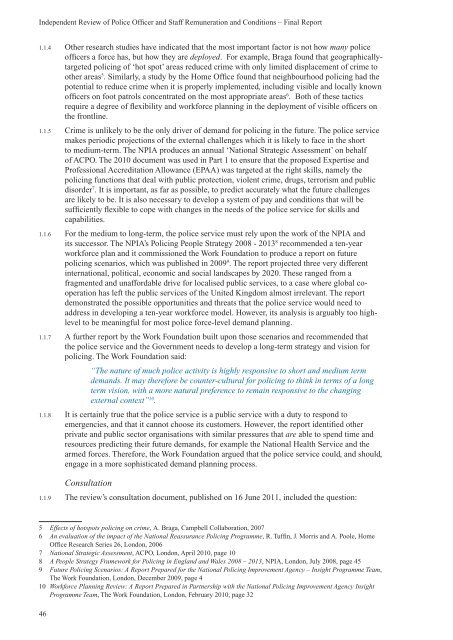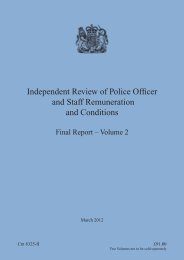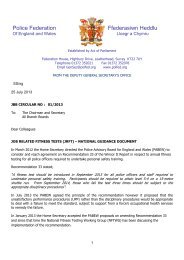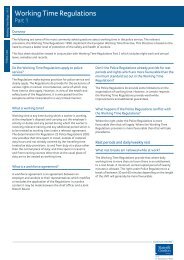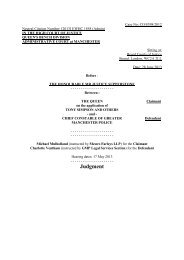Final Report - Volume 1 - the South Wales Police Federation
Final Report - Volume 1 - the South Wales Police Federation
Final Report - Volume 1 - the South Wales Police Federation
You also want an ePaper? Increase the reach of your titles
YUMPU automatically turns print PDFs into web optimized ePapers that Google loves.
Independent Review of <strong>Police</strong> Officer and Staff Remuneration and Conditions – <strong>Final</strong> <strong>Report</strong>1.1.4 O<strong>the</strong>r research studies have indicated that <strong>the</strong> most important factor is not how many policeofficers a force has, but how <strong>the</strong>y are deployed. For example, Braga found that geographicallytargetedpolicing of ‘hot spot’ areas reduced crime with only limited displacement of crime too<strong>the</strong>r areas 5 . Similarly, a study by <strong>the</strong> Home Office found that neighbourhood policing had <strong>the</strong>potential to reduce crime when it is properly implemented, including visible and locally knownofficers on foot patrols concentrated on <strong>the</strong> most appropriate areas 6 . Both of <strong>the</strong>se tacticsrequire a degree of flexibility and workforce planning in <strong>the</strong> deployment of visible officers on<strong>the</strong> frontline.1.1.5 Crime is unlikely to be <strong>the</strong> only driver of demand for policing in <strong>the</strong> future. The police servicemakes periodic projections of <strong>the</strong> external challenges which it is likely to face in <strong>the</strong> shortto medium-term. The NPIA produces an annual ‘National Strategic Assessment’ on behalfof ACPO. The 2010 document was used in Part 1 to ensure that <strong>the</strong> proposed Expertise andProfessional Accreditation Allowance (EPAA) was targeted at <strong>the</strong> right skills, namely <strong>the</strong>policing functions that deal with public protection, violent crime, drugs, terrorism and publicdisorder 7 . It is important, as far as possible, to predict accurately what <strong>the</strong> future challengesare likely to be. It is also necessary to develop a system of pay and conditions that will besufficiently flexible to cope with changes in <strong>the</strong> needs of <strong>the</strong> police service for skills andcapabilities.1.1.6 For <strong>the</strong> medium to long-term, <strong>the</strong> police service must rely upon <strong>the</strong> work of <strong>the</strong> NPIA andits successor. The NPIA’s Policing People Strategy 2008 - 2013 8 recommended a ten-yearworkforce plan and it commissioned <strong>the</strong> Work Foundation to produce a report on futurepolicing scenarios, which was published in 2009 9 . The report projected three very differentinternational, political, economic and social landscapes by 2020. These ranged from afragmented and unaffordable drive for localised public services, to a case where global cooperationhas left <strong>the</strong> public services of <strong>the</strong> United Kingdom almost irrelevant. The reportdemonstrated <strong>the</strong> possible opportunities and threats that <strong>the</strong> police service would need toaddress in developing a ten-year workforce model. However, its analysis is arguably too highlevelto be meaningful for most police force-level demand planning.1.1.7 A fur<strong>the</strong>r report by <strong>the</strong> Work Foundation built upon those scenarios and recommended that<strong>the</strong> police service and <strong>the</strong> Government needs to develop a long-term strategy and vision forpolicing. The Work Foundation said:“The nature of much police activity is highly responsive to short and medium termdemands. It may <strong>the</strong>refore be counter-cultural for policing to think in terms of a longterm vision, with a more natural preference to remain responsive to <strong>the</strong> changingexternal context” 10 .1.1.8 It is certainly true that <strong>the</strong> police service is a public service with a duty to respond toemergencies, and that it cannot choose its customers. However, <strong>the</strong> report identified o<strong>the</strong>rprivate and public sector organisations with similar pressures that are able to spend time andresources predicting <strong>the</strong>ir future demands, for example <strong>the</strong> National Health Service and <strong>the</strong>armed forces. Therefore, <strong>the</strong> Work Foundation argued that <strong>the</strong> police service could, and should,engage in a more sophisticated demand planning process.Consultation1.1.9 The review’s consultation document, published on 16 June 2011, included <strong>the</strong> question:5 Effects of hotspots policing on crime, A. Braga, Campbell Collaboration, 20076 An evaluation of <strong>the</strong> impact of <strong>the</strong> National Reassurance Policing Programme, R. Tuffin, J. Morris and A. Poole, HomeOffice Research Series 26, London, 20067 National Strategic Assessment, ACPO, London, April 2010, page 108 A People Strategy Framework for Policing in England and <strong>Wales</strong> 2008 – 2013, NPIA, London, July 2008, page 459 Future Policing Scenarios: A <strong>Report</strong> Prepared for <strong>the</strong> National Policing Improvement Agency – Insight Programme Team,The Work Foundation, London, December 2009, page 410 Workforce Planning Review: A <strong>Report</strong> Prepared in Partnership with <strong>the</strong> National Policing Improvement Agency InsightProgramme Team, The Work Foundation, London, February 2010, page 3246


